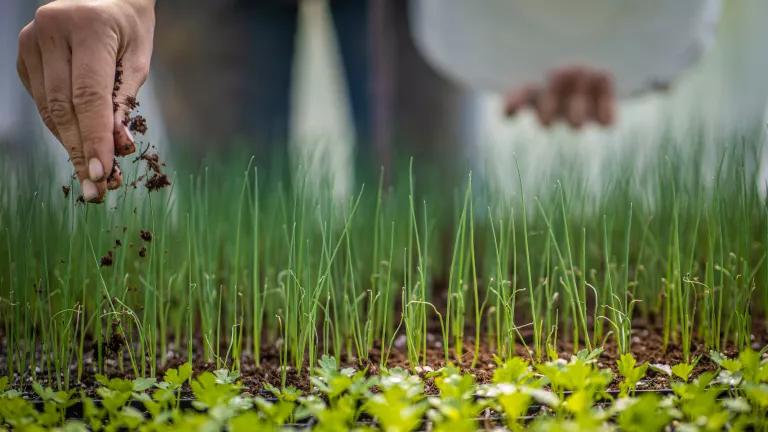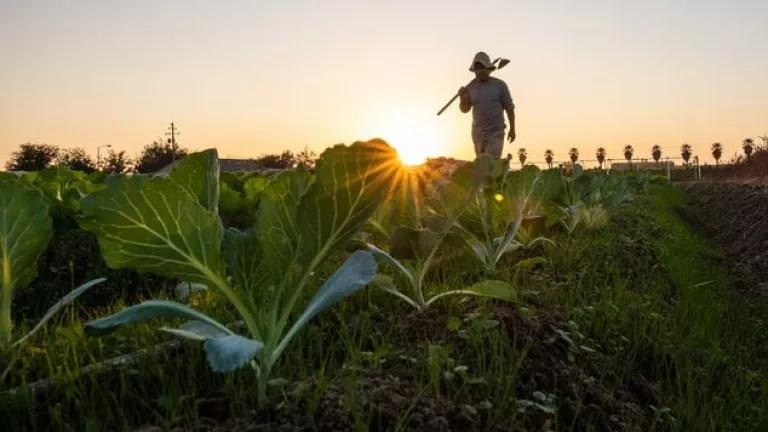Microbes Matter: What the Biodiversity Report Means for Soil

On May 6th, a summary of the Global Assessment on Biodiversity was released, and it is harrowing. The report finds that 23 percent of our agricultural lands are less productive than five years ago. In refreshingly bold terms, the report comments on the role agricultural subsidies play in catalyzing soil health degradation and biodiversity loss. Agricultural subsidies are problematic because, too often, subsidy policies do not consider the impacts of the farming practices used to grow the crops that are subsidized. The United States Government provides subsidies through the Federal Crop Insurance Program (FCIP) regardless of the practices used to grow crops. This payment-for-production structure ignores the environmental and public health externalities of producing commodity crops intensively and provides no incentive for farmers to change their on-farm behavior and employ farming techniques that build soil health.
Almost one third of the 320 million acres of harvested cropland in the United States is used to grow corn, and another one third is used to grow soybeans. Most of these corn and soybean crops are not grown for human consumption, they’re exported or used as feedstock for livestock, but they are two of the most heavily subsidized crops in the United States.
- When 97 percent of all the acres in corn production and 28 percent of all the acres in soybean production are applied with fertilizers, soil health suffers.
- When 97 percent of all the acres in corn production and 95 percent of all the acres in soybean production are sprayed with herbicides, soil health suffers.
- When 36 percent of all acres in corn production and 28 percent of all the acres in soybean production till their fields, soil health suffers.
The Global Assessment states “harmful economic incentives…associated with unsustainable practices of fisheries, aquaculture, agriculture (including fertilizer and pesticide use) …are often associated with [the] overexploitation of natural resources…(B5).” Chemicals and synthetic fertilizers promise short-term boosts in crop yields, but the overapplication and reliance on chemicals and synthetic fertilizers on commodity farms create soil conditions that are inhospitable for the soil microbiome.
Healthy soil is alive. 1 teaspoon of healthy soil can support a microbiome of 1 billion organisms like bacteria, fungi, and earthworms. The microbes in our soil provide nutrients, carbon, and water to plants, which means when our soil microbiome is well-fed and supported, our soil and our plants are healthier. Our soil ecosystem is the greatest concentration of biomass anywhere on the planet, but when the federal government pays crop insurance without considering the practices that are used to grow those crops, our soil microbiome pays the price. Microbes matter, because:
- The microbes in our soil help sequester carbon. The microbes in our soil all need one thing to live: carbon. Our plants pump excess carbon from the atmosphere into the soil to support microbial health and biodiversity. When soil is contaminated by toxic pesticides, fungicides, and insecticides, the harsh chemicals reduce microbial populations in the soil. Fewer microbes in the soil mean fewer organisms to consume and sequester carbon in the soil. By spraying crops with harmful chemicals, we reduce the soil’s capacity to act as a carbon sink.
- The microbes in our soil help retain water and use it more efficiently. Mycorrhizal fungi, a critical component of the soil microbiome, provide nutrients and water to plant roots. Mycorrhizal fungi are only found on living plant roots, and they build intricate nutrient and water highways through soil so that plants can access nutrients and water from faraway places (see image to the right). Not only do the highways transmit water, when the mycorrhizal fungi build their highways, they puncture the soil and create pockets of space for additional water to be stored. Healthy soil can hold up to 20 times its weight in water, and the highways that mycorrhizal fungi grow provide water security for plants during droughts. Mycorrhizal fungi only grow near living roots. When industrial agricultural practices encourage farmers to till, to rip living roots out from the soil so that their crop rows look “clean,” or when farmers fallow their fields and skip a growing season, mycorrhizal fungi populations are not supported. When mycorrhizal fungi populations are not supported, soil cannot sequester as much water, and our crops are less resilient during drought.
- The microbes in our soil keep our food healthy. When plants photosynthesize, they break down water and convert the energy from the sun to form sugars. Whatever sugars the plant doesn’t use, it pumps into the soil to feed the microbes and fungi. In return, the fungi provide nutrients like organic nitrogen, phosphorous, calcium, and zinc to the plant. Diverse fungi species help plants access a variety of nutrients, and this nutrient exchange keeps our plants healthy and nutrient-rich. Monocropping, an industrial agriculture practice supported by agricultural subsidies, does not support mycorrhizal fungi diversity, and the nutrient density of our fruits and vegetables is suffering. The lack of biodiversity above ground affects the biodiversity below ground.
The Global Biodiversity Assessment is clear: We need to reconsider what types of agricultural systems are supported by taxpayer dollars. Every year for the last ten years, the federal government has paid farmers an average of $8 billion in crop insurance payments through the FCIP, and a significant portion of these federal subsidies go to commodity farms that employ agricultural practices that degrade soil health, like nondiverse crop rotations, heavy fertilizer and pesticide use, and tillage. The billions of dollars of subsidies paid by the federal government should not support degenerative agricultural practices. For the sake of biodiversity protection and soil health, we should reward farmers for treating their farms as biodiverse, microbe-rich ecosystems. Policy should incentivize soil building practices like crop diversity, cover crops, crop rotations, integrated livestock management, and no-till.
NRDC advocates for regenerative agricultural systems that support microbial biodiversity and soil health, and our campaign to reform the FCIP involves making it easier for farmers who practice soil-building techniques to access the FCIP. We also worked with a diverse coalition of agricultural and business groups to successfully pass a new Soil Health Demonstration Trial provision in the last Farm Bill. This provision will reward farmers for adopting soil-building practices that sequester carbon in the soil.
The Global Biodiversity Assessment calls out the dangerous trajectory of current agricultural subsidies. We’ve hit the snooze button too many times on subsidy reform, and it’s time for our policymakers to wake up to biodiversity losses perpetuated by this broken system.



